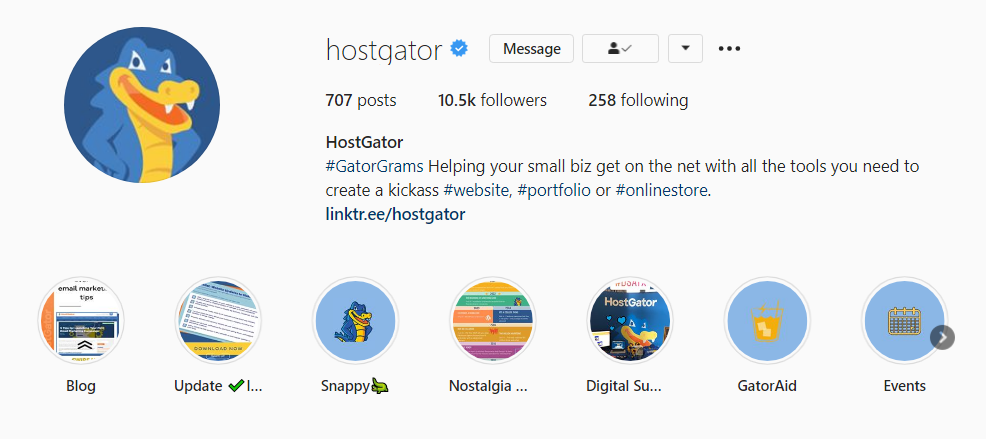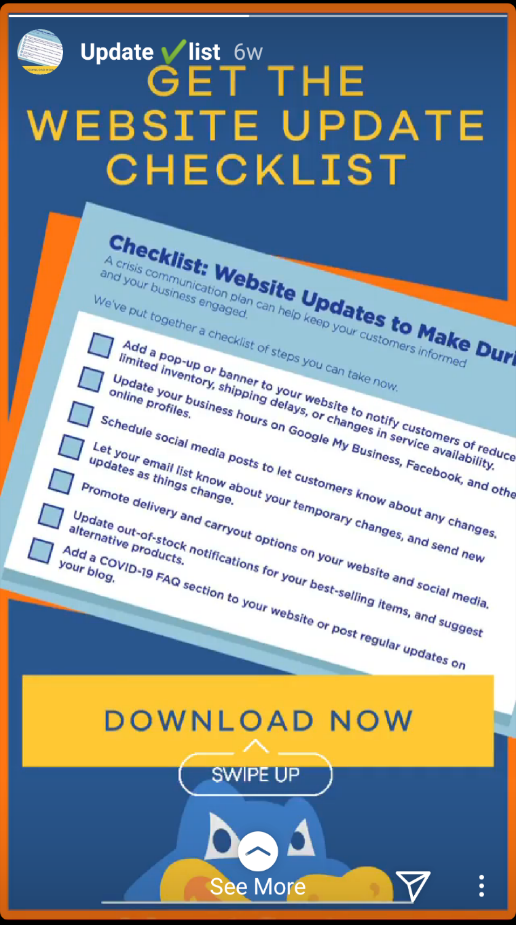By Emily Hill and Jana Thibodeaux
This article is part of Virtue Media’s Web Pros Series. In this series, we feature articles from our team of experts here at Virtue Media. Our Product Managers, Linux Administrators, Marketers, and Tech Support engineers share their best tips for getting the most from your website.
Even if you don’t use Facebook Stories and Instagram Stories, you’ve probably seen them – those short photo and video snippet displays that appear at the top of your feed. Maybe you’re a fan, maybe you’re already Story-proficient, but maybe you’re wondering what the point of Stories is when you can already post videos and photos in your feed.
Why should your business use Stories? Here are our top 5 reasons.
There are several big reasons why we recommend Stories to businesses.
1. Your Story appears at the top of your followers’ feeds.
When you do a normal Instagram or Facebook post, it’s up to the algorithm who sees it, and as new content gets published, your post moves farther and farther down where people are less likely to see it.
Our No. 1 reason to use Stories is because they automatically show up at the top of users’ home feeds the entire time it’s available (usually 24 hours). You get optimized placement without having to pay for it just by doing an Instagram or Facebook story.
On Instagram, you can keep your Stories visible even after they expire by adding them to your Highlights. Then they’ll live at the top of your profile page, just beneath your profile image.

2. Stories can take your followers behind the scenes.
Maybe it’s a (safely socially distanced) event, maybe it’s the server room at your business, or the kitchen where your restaurant crew is turning out to-go orders. Showing your followers something that they wouldn’t otherwise get to see can build interest for your business.
3. Stories can get more people engaged with your brand.
So, your followers can find your Stories easily—right at the top of their feeds—and they can feel like they’re right there with you doing something interesting. That leads to reason #3 to market with Stories: more audience engagement.
What we’ve found is that people engage more with our Stories on Instagram than they do with regular posts. There are more comments and more responses to polls, for example. That’s probably because there are more interactive Story elements, like stickers.
4. Stories can raise your click-through rates.
When people interact more with your brand, they often want to learn more. You may find that you’re getting more clicks through the link in your profile as you build up Story content.
As you grow your followers, you can unlock more features that can boost click-throughs. For example, once you have 5,000 Instagram followers, you can include a link in your Story posts, something you can’t do with in a standard Instagram post.
At 10,000 followers, Instagram lets you add its Swipe Up feature on your Stories. That lets followers go straight from your Story to your store or your blog.
For example, followers can swipe up on this Story to learn more about website updates and then read our blog post.
5. Stories let you market on a shoestring audio/video budget.
Unlike most promotional videos, product portfolios and podcasts, a Story can succeed even with lo-fi production values. The idea is that your Story is something that’s happening in the moment, shot on your phone. You don’t need to invest in a graphic designer and video producer, which makes Stories fast to create and easy on your budget.
How to create Stories for your business: 11 smart ideas
When you’re ready to start using Stories in your marketing, you may wonder how long they should be and how often you should post them. Here’s what we recommend for most new Stories users.
1. Tell an actual story.
Even a fifteen-second story should have a beginning, a middle and an end. For an artist, a Story about a mural project could be three images: the sketch, halfway point and finished product.
2. Keep your Stories brief.
In each Story, you can create individual pages that display for up to five seconds for an image and up to 15 seconds for a video. We recommend including anywhere from three to six pages in each Story.
3. Mix your media.
Mix and match video and still images in your Stories. A little bit of a both in each Story can boost views and get your audience more engaged.
4. Go vertical.
Instagram and Facebook posts have a square format. Stories use a portrait (vertical) format that fills the screen. When you’re taking photos and videos for your feed and Stories, remember to take a couple of different sizes so you have content for both formats.
5. Use content you already have.
When there’s something timely from your feed that you can include in your Stories, do it. For example, you might have past holiday posts you can build into a Story for the upcoming holiday season. Or maybe you’ve got a series of related product photos you can string together into a Story.
6. Brand your Stories
Branding always matters! You can create Story backgrounds in another platform like Canva to include your brand’s colors and fonts, instead of relying on the fonts and colors available in Stories. That’s a good way to help make sure all your content looks and feels like your brand.
7. Use #hashtags in your Stories.
Some marketers put hashtags front and center on their Stories, while others shrink them so they’re unobtrusive. The important thing is to use at least one hashtag on every post, because they make your posts findable in hashtag searches.
8. Get brave and do some live posts.
Maybe you’re at an event, maybe you’re in your workshop or office—show your followers what’s happening right now. If there’s something really cool going on, you can make a quick video for your Story.
You can also stream live video for up to an hour on Instagram and up to 90 minutes on Facebook. Then you can leverage the replay. On Instagram, you can save your video to IGTV if it meets the length and format requirements. You may also be able to include your IGTV video in your Stories, although Instagram doesn’t give every user that option.
9. Add your best Stories to your Highlights.
Instagram will display them near the top of your profile page, long after they’ve left the Stories feed.
10. Start small with Stories.
It’s tempting to try to be everywhere at once with Stories, but it’s best to take baby steps when you’re starting. If most of your audience is on Facebook, focus your Story efforts there. If they’re on Instagram, start there. If you have followers on both, you can set up Instagram to share your Stories to Facebook automatically.
How often should you post? Again, baby steps are best. One to two Stories per week is a good place to start. However, don’t feel like you have to hit that target every single week.
Remember, Stories are part of a conversation with your audience. Maybe there’s a week when you’re out or don’t really have anything to talk about with your audience. That’s okay. Maybe the next week there are three cool things you want to turn into Stories. That’s good, too! Don’t avoid Stories just because you’re not sticking to a schedule.
11. Engage with your Stories audience.
Stories are great for getting more engagement from your followers. They’re also great for getting more insights from them. Use those Story conversations and polls to get feedback from your customers and have actual conversations that can build those relationships and strengthen your brand.
Read more from Virtue Media’s Web Pro Series. Check out these articles for growing your business:






![Yes, B2B Websites Can Use Personalization Too [Here’s How]](https://mdvirtue.com/wp-content/uploads/2022/02/Yes-B2B-Websites-Can-Use-Personalization-Too-Heres-How-400x250.jpeg)

0 Comments